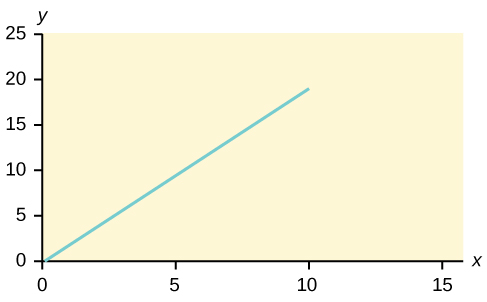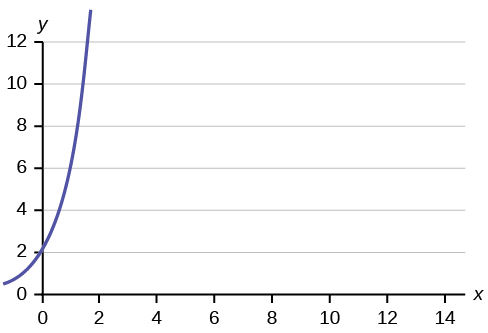12.1 Linear Equations
LEARNING OBJECTIVES
- Identify a linear equation, graphically or algebraically.
In this chapter, we will be studying simple linear regression, which models the linear relationship between two variables [latex]x[/latex] and [latex]y[/latex]. A linear equation has the form [latex]y=b_0+b_1x[/latex] where [latex]b_0[/latex] is the [latex]y[/latex]-intercept of the line and [latex]b_1[/latex] is the slope of the line. For example, [latex]y=3+2x[/latex] and [latex]y=1-4x[/latex] are examples of linear equations. The graph of linear equation is a straight line.
EXAMPLE
TRY IT
The slope [latex]b_1[/latex] is a number that describes the steepness of a line. The slope tells us how the value of the [latex]y[/latex] variable will change for every one-unit increase in the value of the [latex]x[/latex] variable.
The [latex]y[/latex]-intercept [latex]b_0[/latex] is the value of the [latex]y[/latex]-coordinate where the graph of the line crosses the [latex]y[/latex]-axis. Algebraically, the [latex]y[/latex]-intercept is the value of [latex]y[/latex] when [latex]x=0[/latex].
Consider the figure below, which illustrates three different linear equations:
- In (a), the line rises from left to right across the graph. This means that the slope [latex]b_1[/latex] is a positive number ([latex]b_1 \gt 0[/latex]).
- In (b), the line is horizontal (parallel to the [latex]x[/latex]-axis). This means that the slope [latex]b_1[/latex] is zero ([latex]b_1=0[/latex]).
- In (c), the line falls from left to right across the graph. This means that the slope [latex]b_1[/latex] is a negative number ([latex]b_1 \lt 0[/latex]).
EXAMPLE
Consider the linear equation [latex]y=-25+15x[/latex].
- The slope is [latex]15[/latex]. This tells us that when the value of [latex]x[/latex] increases by [latex]1[/latex], the value of [latex]y[/latex] increases by [latex]15[/latex]. Because the slope is positive, the graph of [latex]y=-25+15x[/latex] rises from left to right.
- The [latex]y[/latex]-intercept is [latex]-25[/latex]. This tells us that when [latex]x=0[/latex], [latex]y=-25[/latex]. On the graph of [latex]y=-25+15x[/latex], the line crosses the [latex]y[/latex]-axis at [latex]-25[/latex].
TRY IT
Consider the linear equation [latex]y=17-10x[/latex]. Identify the slope and [latex]y[/latex]-intercept. Describe the slope and [latex]y[/latex]-intercept in sentences.
Click to see Solution
- The slope is [latex]-10[/latex]. This tells us that when the value of [latex]x[/latex] increases by [latex]1[/latex], the value of [latex]y[/latex] decreases by [latex]10[/latex]. Because the slope is negative, the graph of [latex]y=17-10x[/latex] falls from left to right.
- The [latex]y[/latex]-intercept is [latex]17[/latex]. This tells us that when [latex]x=0[/latex], [latex]y=17[/latex]. On the graph of [latex]y=17-10x[/latex], the line crosses the [latex]y[/latex]-axis at [latex]17[/latex].
Exercises
- Is the equation [latex]y=10+5x–3x^2[/latex] linear? Why or why not?
Click to see Answer
Not linear.
- Which of the following equations are linear?
- [latex]y=6x+8[/latex]
- [latex]y+7=3x[/latex]
- [latex]y–x=8x^2[/latex]
- [latex]4y=8[/latex]
Click to see Answer
(a), (b), and (d) are linear.
- The price of a single issue of stock can fluctuate throughout the day. A linear equation that represents the price of stock for Shipment Express is [latex]y=15–1.5x[/latex] where [latex]x[/latex] is the number of hours passed in an eight-hour day of trading.
- What is the slope? Interpret the slope's meaning in the context of the question.
- What is the [latex]y[/latex]-intercept? Interpret the [latex]y[/latex]-intercept's meaning in the context of the question.
- If you owned this stock, would you want a positive or negative slope? Why?
Click to see Answer
- [latex]-1.5[/latex]. For each additional hour that passes during the trading day, the price of the stock decreases by [latex]\$1.50[/latex].
- [latex]15[/latex]. At the start of the trading day, the price of the stock is [latex]\$15[/latex].
- Positive slope because that means the price of the stock is increasing.
"12.2 Linear Equations" and "12.8 Exercises" from Introduction to Statistics by Valerie Watts is licensed under a Creative Commons Attribution-NonCommercial-ShareAlike 4.0 International License, except where otherwise noted.




